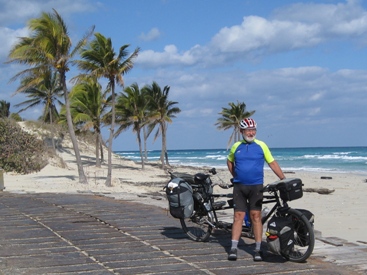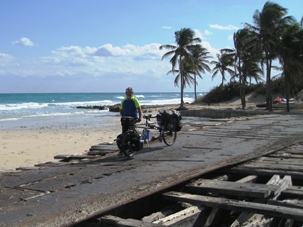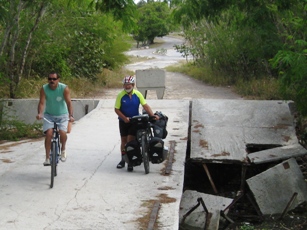Trinidad, Cuba. This year's destination?
1st to 8th March 2009
5th Cycling Week Matanzas to Havana

|
A lovely Caribbean beach |
Tour Day 34 Sunday 1st March Matanzas to Playa Jibacoa
This is our last week of cycling Cuba, making our way back to Havana slowly with some short rides. The latest news is that the Melfi Iberia is due on 7th March.
We were pedalling up the hill out of Matanzas perspiring gently in the sunshine. Coming the other way was our cycle racing friend whom we had met on the way out. Yes he had cycled in the Tour of Cuba for his Havana Team. He had come a very creditable twentieth and his team had finished fifth. He also came tenth in the King of the Mountains competition. With our limited Spanish and his limited English we may have got the details wrong but he was pleased that we had seen the finish in Santa Clara.
As we came towards the end of the ride there were black clouds massing. For the first time since we have been in Cuba the wind was from the west. The management whipped the stoker into unreasonable effort to reach our destination before it rained. The stoker resented this just as much as the horses must especially as the sky brightened and the clouds disappeared.
In the absence of a casa particular we checked into a campismo. They are preferable to hotels, being cheaper and the separate bungalows are more pleasant than decrepit hotel rooms. This one is mainly occupied by Cubans. On the upside the food is better than the poisonous rubbish dished up to tourists and the Cubans are so friendly. On the downside we have to put up with lots of noise and bongo drum music.
The restaurant staff came and collected us from our cabin for dinner. Being among the very few non Cubans here we get this special treatment. Unfortunately the dark clouds had returned accompanied by a strong wind. Our normally ideal dining situation was spoilt a little by the wind. It was on a platform overlooking the sea sheltered by a thatched roof.
With us at dinner were a pleasant Canadian family from Alberta. We talked about visiting the ranches when we cycled to Calgary in 2004 before putting Cuba and the world to rights. Nine year Gillian was able to explain to the management how the last Harry Potter book was resolved which he thinks is pretty clever.
Tour Day 35 Monday 2nd March Playa Jibacoa to Guanabo
It was a most untypical day. We set the alarm early to get going before it got too hot. Looking out just after dawn it was cloudy with a strong north wind still blowing. It was cold enough for us to put our fleeces on.
We seriously considered staying here another night but the stoker was not keen. She wanted to be nearer to Havana in case the ship is early. What finally decided us was that the water was off. It is sad and typical of Cuba that they build a pleasant facility like this but mess up on the water supply. Having no water is seriously smelly even on a cold day so on we went.
Much of the cycling was on the Via Blanca main road against a strong side wind. It was hard work. It did however have a couple of good points. The road follows the coastline closely and the crashing waves were spectacular. Not of course as good as Chesil in a westerly gale but then you can’t cycle along Chesil. We were sometimes only a few metres from the sea and tasted the spray. The huge waves were breaking on the reef about 50 metres out and rolling on towards the road and us.
The other good thing was that the cool day and strong wind kept the pollution to a minimum. The route passes through Cuba’s almost dry oil fields. Even so they stink and on a hot day as the sun comes up the pollution makes eyes water. You can never trust an oil man to be honest about the environmental damage they have and are doing everywhere.
We think Guanabo must, only a short time ago, have been popular with Cubans as a holiday place. Now the town, especially towards the sea, is very run down. The palm fringed beach is pleasant and it is a shame to see it abandoned. We were pleased that our prebooked casa was expecting us and looked forward to and got good food.
While exploring the town we got into conversation with a very elderly gentleman. He had no teeth and like many people here very poor eye sight. Having established that we were English he spoke to us very clearly in our own language. We asked him where he learned and apologised for our poor Spanish. He said he had learned at school. He put us in our place by saying we should go to school like he did, to learn Spanish. What a nice man and he was 85.
 |
The bridge survived long enough for us to get across |
Tour Day 36 Tuesday 3rd March Guanabo to Cojimar
We decided to make this short ride interesting. We did this by doing our best to follow the directions in the Lonely Planet Cycling Cuba book to the letter. As the book was published in 2002 and surveys done well before that, much has changed.
We left Guanabo westwards along the coast which is picture book Caribbean. The beach is classic white sand fringed with palm trees. While the wind from yesterday had reduced the waves were still large and swimming looked dangerous.
After pushing the tandem through sand which had blown over the road we reached a rickety bridge. We were able to cross but it was no longer open to other vehicles. On the other side of the bridge we entered what had been intended as hotel land.
Hotel land despite the lovely beach was a depressing place. Smallish nondescript hotels had been built along the main drag but nothing like as many as the road system suggested. Of these most were deserted and several were abandoned with windows and frames removed. Being Cuba even though they had few customers there were still hotel “workers” in plenty. There were even taxis and buses waiting. No doubt the great party director in Havana says it will be so and so it is.
From here for a while the route cleverly avoided the main Via Blanca road. The book directed us to cycle through a large army camp. We approached the guarded gate and unsurprisingly were not allowed through. Perhaps security levels are higher in 2009 but it is more likely to be caused by the Cuban paranoia for securing things.
Skirting the camp the authorities might have been better letting us through. Instead of seeing marching solders we had an amusing display of kisses and cuddles behind the mess hut. We prefer them making love not war.
We were soon back on the route, the old road now replaced by the Via Blanca. Unlike what happens in most places when a new road is built the Cubans did not close the old road to cyclists. After so many years it is now very pot holed and our progress was slow. We came to a river bridge which we crossed with trepidation. One side of the slab concrete bridge had already collapsed. The remaining side looked dodgy, but then why should it choose the time of our crossing to collapse?
Crossing the bridge brought us into Alamar which is billed as the largest social housing development in the world. We don’t think anyone we know would like to live there. It is formed of many blocks of flats varying from five to about ten floors high. All that can be said for it is that perhaps it is better than the slum conditions it replaced. Furthermore, just as everywhere else we have been in Cuba, we did not feel at risk. As usual the many people around were either friendly or ignored us.
At this point our route was gently blocked by a 1950s Vauxhall Victor estate car in good but well used condition. The stoker was about to remonstrate, it is unusual here for cars to get in the way of bikes. The driver put his head out of the ancient window. He introduced himself as Chico, the host at our next casa, come to see that we were on the right road. We later learned that the car had been bought by his father.
We hope today’s diary does not sound negative. We enjoyed the ride and it was fun to try to do what we know was possible some ten years ago. It reinforced the strong feeling we have had during this tour of the decline over that time but the cycling is still pretty good.

|
We had a little more confidence in this bridge when we saw local cyclists using it. But we did not linger. |
Tour Days 37 to 41 Wednesday 4th to Sunday 8th March Cojimar and around
Cojimar is a most unlikely place. The Lonely Planet gives it a complimentary billing and the more recent Rough Guide only briefly mentions it. It has two claims to fame. It was the place where Ernest Hemingway kept his boat and the site of the 1992 Panamerican Games.
It seemed a place we could hold up for a couple of days before returning to Havana to board the ship. We had been referred to Chico’s casa particular by the Guanabo casa. We followed the directions past the crumbling athletics stadium, velodrome and defunct hotel to a 2km grid of roads. These bridged the gap between stadium and the fishing village.
Plunging into the grid was a shock. Even the larger roads were badly potholed and the minor ones just dirt. To our untrained eye it looked like a slum. Low shacks of wood or peeling concrete were crammed in, each surrounded by its own chicken wire “security fence”. Litter was common and in places it stank. We could not believe we would stay here.
Following the directions we came to a wide unmade road and saw Chico’s sign. In a country where even the better properties are poor Chico’s looked good. The obligatory security fence looked neat and tidy. The house behind it was freshly painted and quite large. With nothing to be lost we rung the bell.
We were amazed by what we found. The villa was in perfect order and would not be out of place in civilised Spain. Our apartment, for that is what it was, was at first floor level and opened onto a fine roof terrace. Like the rest of the house it was carefully fitted out and well decorated. Everything worked and in a good and safe condition and we even had constant hot water.
We soon decided to stay here until the ship arrived. We took advantage of Chico’s privileged house and withdrew behind his security fence. We treat this as a stark warning of what might happen in the UK if public services are not properly maintained. Stinking, uncleaned streets with those who can afford it living in comfort in gated communities or behind security fences. We prefer to pay our Council Tax.
Chico is living in his family house. We don’t know how he got the money or resources to keep it so well. He must be a perfectionist and perhaps a tyrant. Obtaining anything here which works well is difficult. Getting it fitted properly and correctly finished has eluded Cubans everywhere else we have stayed.
We visited Hemingway’s memorial at the “fishing village” on the other side of the housing grid. It is sad to see both the long term and recent decline of this place. In Hemingway’s day it must have been both pleasant and opulent. There are still the decaying structures of several fine mansions and the waterside may once have been pleasant. The deep bay where he kept his boat is now backed by the dreadful looking high rise of Alamar. Opposite Hemingway’s bar on the other side of the bay is an oil drilling rig and oil being flared off. The management was not tempted to go snorkelling.
From our privileged house it was just 5km to the cross harbour ferry to Havana and we took this a couple of times. We used the internet, collected the bag we had left with Luis, and also visited some “attractions” which we had not been to before.
We visited Revolution Square where there is a monument to José Marti flanked by an iconic sculpture of Che Guevara. The monument takes no account of human scale and feels intimidating. Perhaps one day the people currently enslaved by this unelected administration of communists will see through them. It is ironical that the communists glorify José Marti who with others was instrumental in ending slavery here.
One small incident has to be recorded. It hinges on a genuine mistake by the stoker. A jugo in Spanish is not a jug but a glass. While searching the empty shops for fresh fruit without success we came across a stall pressing and selling fresh orange juice. It costs one peso which is worth about 3p for a “jugo”. The locals were bringing their bottles to be filled. We walked home and the management volunteered to walk back down with our bottles.
The management does not do money and seldom carries any, leaving such things to the stoker. He was given six pesos and told to bring back the change. He joined the inevitable queue and his two bottles were filled with lovely fresh orange juice. “Seven pesos please”, he was shocked and pointed to the sign, “one peso a jugo”. He was shown the glass.
Everyone in the ever increasing queue of Cubans had come across the impossible and did not contain their mirth. An obvious tourist, wealthy and soft, did not have one extra peso for his orange juice. Eventually the shop keeper relented and took the management’s six pesos, 18p, rather than the 21p due. He walked home as quickly and unobtrusively as a tourist in Cuba can, all street credibility gone.
On our final day here we loaded the tandem and cycled the 5km to the harbour ferry. Our last act on Cuban soil was to buy a litre bottle of rum and some lemonade. This was to kept us going with mojitos until the colder weather indicates the need for whisky from the ship’s “slops” chest.
Home
Cuban tips + tricks
Route and Navigation
Voyage Out 1
Voyage Out 2
Week 1
Week 2
Week 3
Week 4
Week 5
Return Voyage 1
Return Voyage 2
Cargo Ship Travel
Stoker's Leg
Bike and Gear
Transporting Bikes
Photos
Links and Downloads